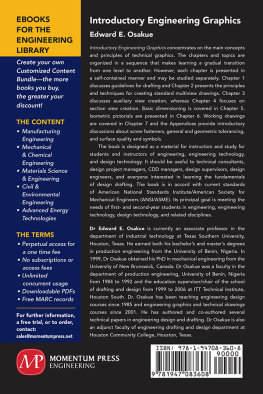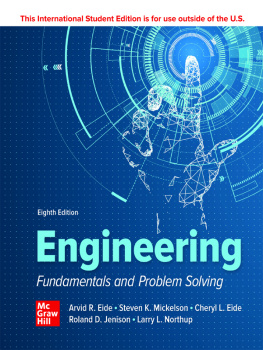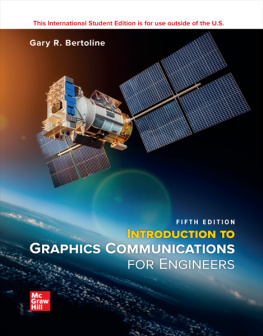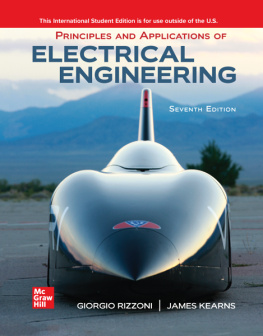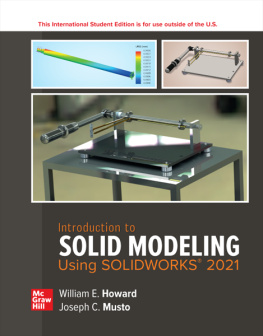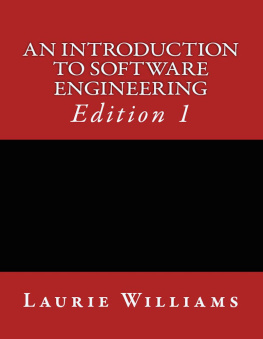Osakue - Introductory Engineering Graphics
Here you can read online Osakue - Introductory Engineering Graphics full text of the book (entire story) in english for free. Download pdf and epub, get meaning, cover and reviews about this ebook. City: New York, year: 2018, publisher: Momentum Press, genre: Children. Description of the work, (preface) as well as reviews are available. Best literature library LitArk.com created for fans of good reading and offers a wide selection of genres:
Romance novel
Science fiction
Adventure
Detective
Science
History
Home and family
Prose
Art
Politics
Computer
Non-fiction
Religion
Business
Children
Humor
Choose a favorite category and find really read worthwhile books. Enjoy immersion in the world of imagination, feel the emotions of the characters or learn something new for yourself, make an fascinating discovery.
Introductory Engineering Graphics: summary, description and annotation
We offer to read an annotation, description, summary or preface (depends on what the author of the book "Introductory Engineering Graphics" wrote himself). If you haven't found the necessary information about the book — write in the comments, we will try to find it.
Osakue: author's other books
Who wrote Introductory Engineering Graphics? Find out the surname, the name of the author of the book and a list of all author's works by series.
Introductory Engineering Graphics — read online for free the complete book (whole text) full work
Below is the text of the book, divided by pages. System saving the place of the last page read, allows you to conveniently read the book "Introductory Engineering Graphics" online for free, without having to search again every time where you left off. Put a bookmark, and you can go to the page where you finished reading at any time.
Font size:
Interval:
Bookmark:

INTRODUCTORY ENGINEERING GRAPHICS
INTRODUCTORY ENGINEERING GRAPHICS
EDWARD E. OSAKUE

Introductory Engineering Graphics
Copyright Momentum Press, LLC, 2018.
All rights reserved. No part of this publication may be reproduced, stored in a retrieval system, or transmitted in any form or by any meanselectronic, mechanical, photocopy, recording, or any otherexcept for brief quotations, not to exceed 400 words, without the prior permission of the publisher.
First published by Momentum Press, LLC
222 East 46th Street, New York, NY 10017
www.momentumpress.net
ISBN-13: 978-1-94708-360-8 (print)
ISBN-13: 978-1-94708-361-5 (e-book)
Momentum Press General Engineering and K-12 Engineering Education Collection
Cover and interior design by Exeter Premedia Services Private Ltd., Chennai, India
10 9 8 7 6 5 4 3 2 1
Printed in the United States of America
ABSTRACT
Introductory Engineering Graphics concentrates on the main concepts and principles of technical graphics and provides users with the information they need most in an easy and straightforward manner. The chapters and topics are organized in a sequence that makes learning a gradual transition from one level to another. However, each chapter is presented in a self-contained manner and may be studied separately. In each chapter, techniques are presented for implementing the topics treated. , the heart of drafting, and practical information is provided for creating them. The Appendices provide introductory discussions about screw fasteners, general and geometric tolerancing, and surface quality and symbols.
This book is designed as a material for instruction and study for students and instructors of engineering, engineering technology, and design technology. It should be useful to technical consultants, design project managers, computer design drafting (CDD) managers, design supervisors, design engineers, and everyone interested in learning the fundamentals of design drafting. The book is written with full cognizance of current standards of American National Standards Institute/American Society for Mechanical Engineers (ANSI/ASME). The style is plain, and discussions are straight to the point. Its principal goal is meeting the needs of first- and second-year students in engineering, engineering technology, design technology, and related disciplines.
KEYWORDS
auxiliary views, CDD, design, dimensioning, graphics, isometric views, multiview drawings, orthographic projection, section views, shape construction, technical, working drawings
CONTENTS
The technical educational environment has changed dramatically in the last few decades. Instructors and students in design technology, engineering technology, engineering, and related disciplines are faced with limited study time, but with increasing information for training in technical graphics. Contact hours for lectures and laboratories in technical graphics have been shrinking, but product design continues to grow in complexities, and the time to market continues to shrink! New design tools that are largely computer based come into the workplace at astonishing speed. There are more materials to cover, but in fewer contact hours. These challenges need serious considerations, and this book is written to address them.
Instructors are free to use any CDD package of their choice to implement the concepts and principles discussed in each chapter. They may first give a lecture on the chapter and ask the students to answer the chapter review questions. A quiz on the chapter can be created and administered by the instructor before the chapter exercises are attempted. An alternative approach is to assign a chapter as a reading assignment with the students required to answer the chapter review questions before the lecture. A quiz can then be administered after the lecture. These approaches should help the students to understand the rules before playing the game, that is doing the exercises.
Introductory Engineering Graphics is highly condensed so as to maximize the use of production materials. I hope students and teachers, the primary audience, will find the book a valuable resource and enjoy using it. I am deeply grateful to Momentum Presss dedicated team of reviewers for their professional critique and invaluable suggestions. Many thanks to the hundreds of students who have taken my drafting courses for their suggestions and critiques over the years. Please feel free to inform me of any error found and comment(s) for improvement will be highly appreciated. All communications should, please, be channeled through the publisher.
Edward E. Osakue
April, 2018.
1.1 INTRODUCTION
Drafting is the process of creating technical drawings consisting of two-dimensional (2D) images and annotations, and the term draughting is used to describe the language of drafting in this book. Draughting defines the terminology, symbology, conventions, and standards used in drafting. It is the universal technical language that is used for clearly and accurately describing the form, size, finish, and color of a graphic design model for construction or recording. Draughting guidelines deal with standards and conventions in drawing media, lettering, linestyes, projection standards, plot scales, dimensioning rules, sectioning rules, and so on. In this chapter, we will concentrate mainly on drawing media, lettering, and linestyles, while others will be discussed in the appropriate chapters.
The 2D images in drafting are constructed from lines and curves, while annotations are composed from characters. 2D technical drawings may be created using axonometric and perspective principles. Axonometric drawings are 2D drawings obtained by applying orthogonal projection principles to three-dimensional (3D) objects and include orthographic, isometric, dimetric, and trimetric drawings. Pictorial drawings such as isometric and perspective drawings mimic 3D objects in appearance, but are made of 2D entities by composition. Most technical drawings are of the orthographic and isometric types, which are the focus of this book. Some standards and conventions apply to both lines and characters in drafting, and they must be learned and used correctly. Therefore, drafting skills involve learning to correctly apply the rules of draughting in creating acceptable or industry standard technical drawings. Proficiency in drafting involves being able to create high-quality technical drawings, therefore, becoming proficient in drafting must be a commitment executed with determined effort.
1.2 CONVENTIONS AND STANDARDS
Draughting principles, conventions, rules, and standards help to minimize misinterpretations of drawing contents and eliminate errors in the communication of technical ideas. Conventions are commonly accepted practices, methods, or rules used in technical drawings. Standards are sets of rules established through voluntary agreements that govern the representation of technical drawings. Standards ensure clear communication of technical ideas. The design drafter must study and understand these conventions and standards and learn to apply them correctly in practice. For example, good technical drawings are achieved by following some principles such as:
Keeping all lines black, crisp, and consistent.
Using different linestyles.
Ensuring clarity in linestyle differences such as in thickness or line weight.
Ensuring dashes have consistent spacing with definite endpoints.
Next pageFont size:
Interval:
Bookmark:
Similar books «Introductory Engineering Graphics»
Look at similar books to Introductory Engineering Graphics. We have selected literature similar in name and meaning in the hope of providing readers with more options to find new, interesting, not yet read works.
Discussion, reviews of the book Introductory Engineering Graphics and just readers' own opinions. Leave your comments, write what you think about the work, its meaning or the main characters. Specify what exactly you liked and what you didn't like, and why you think so.

